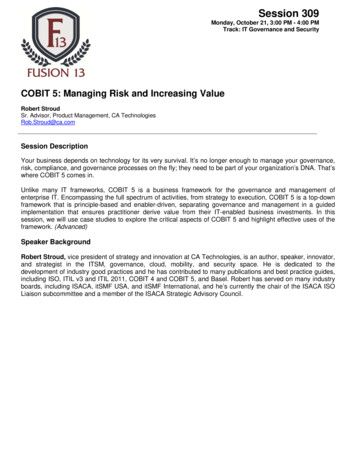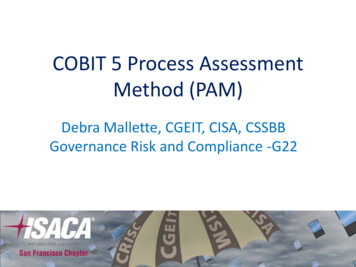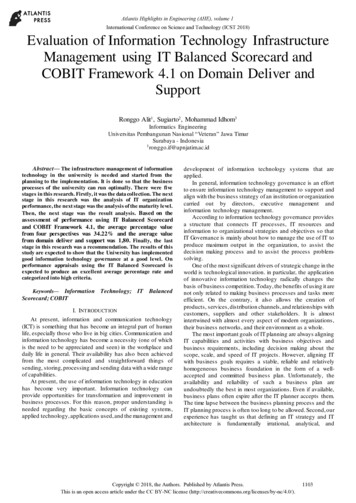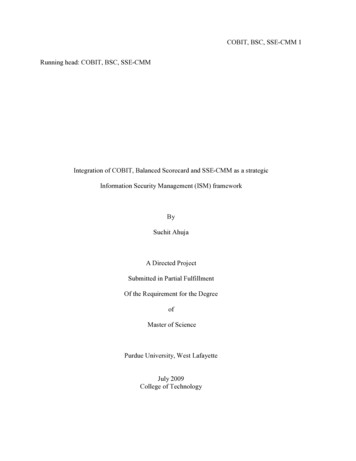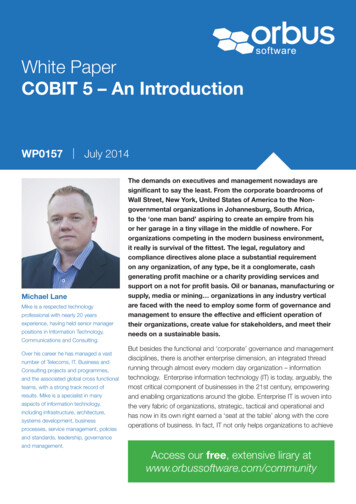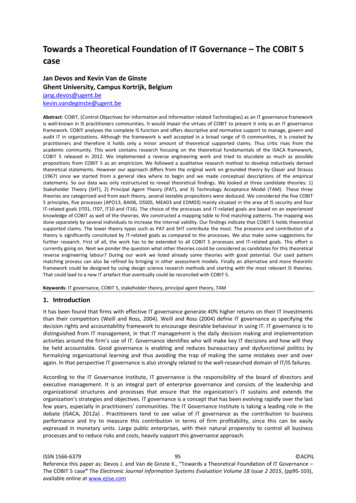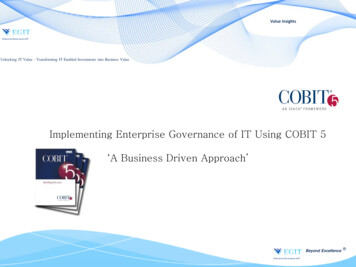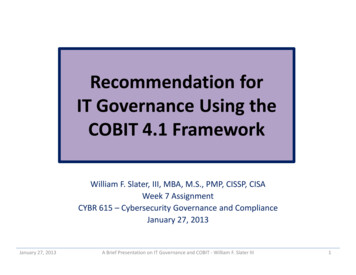
Transcription
Integr ation of COBIT, Balanced Scor ecar d and SSECMM as a str ategic Infor mation Secur ity Management(ISM) fr amewor kSuchit Ahuja1, James E. Goldman11 Purdue University, Department of Computer & Information Technology,West Lafayette, IN 47907, USAAbstr actThe purpose of this study is to explore the integrated use of Control Objectivesfor Information Technology (COBIT) and Balanced Scorecard (BSC)frameworks for strategic information security management (ISM). The goal isto investigate the strengths, weaknesses, implementation techniques, andpotential benefits of such an integrated framework. This integration is achievedby “bridging” the gaps or mitigating the weaknesses that are recognized withinone framework, using the methodology prescribed by the second framework.Thus, integration of COBIT and BSC can provide a more comprehensivemechanism for strategic information security management (ISM) – one that isfully aligned with business, IT and information security strategies. The use ofSystems Security Engineering Capability Maturity Model (SSE-CMM) as a toolfor performance measurement and evaluation can ensure the adoption of acontinuous improvement approach for successful sustainability of thiscomprehensive framework. There are some instances of similar studiesconducted previously: metrics based security assessment [1] using ISO 27001 and SSE-CMM mapping of processes for effective integration of COBIT and SEI-CMM [2] mapping of COBIT with ITIL and ISO 27002 [3] for effective managementand alignment of IT with businessThe factor that differentiates this research study from the previous ones is thatnone of the previous studies integrated BSC, COBIT and SSE-CMM, toformulate a comprehensive framework for strategic ISM that is aligned withbusiness, IT and information security strategies. Therefore, a valid opportunityto conduct this research study exists.Keywor ds: Business/IT Alignment, Business/IT/Information SecurityAlignment, Balanced Scorecard, Strategic Information Security, ControlObjectives for Information Technology (COBIT), Systems SecurityEngineering Capability Maturity Model (SSE-CMM)
1 Intr oductionThreats to security of business information, information-based assets, intellectualproperty, and privacy of personal information are increasing. In order to counter thesethreats, information security management (ISM) is gaining increasing importancewithin organizations, becoming almost imperative as security threats continue toescalate. According to a study by McAfee [4], data theft and breaches fromcybercrime may have cost businesses as much as 1 trillion globally in lostintellectual property and expenditures for repairing the damage in 2008. Regulatorycompliance requirements, loss of revenue, loss of stakeholder confidence, and loss tobrand and reputation are drivers for investment in the implementation of such ISMframeworks (like ISO 27001, ISO 27002, COBIT, etc.) as indicated by Ernst &Young’s (E&Y) Global Information Security Survey in 2008 [5]. This indicates thatinformation security frameworks are used only as a partial solution in order to protectinformation and to secure assets, without integrating them with the business strategy.E&Y [5] also further validates this by reporting that only 18% of the organizationssurveyed had information security strategy as an integrated part of their overallbusiness strategy. This lack of alignment between business, IT and informationsecurity strategies is also highlighted by IT Governance Global Status Report [6],which shows that between 2005 and 2008, the number of organizations reportingdisconnect between IT strategy and business strategy, increased by almost 30%. Inorder to mitigate risks caused by lack of alignment with respect to ISM, a holistic andcomprehensive framework must be developed such that it not only addresses technicalaspects of security but also takes into account business alignment, IT governance, andmeasurement and evaluation [7]. As organizations adopt ISM frameworks moreaggressively, governance, risk management, and compliance (GRC) spendingexceeded 32B for 2008, up 7.4% from 2007 [9]. The use of one ISM framework isinadequate to address ISM requirements comprehensively, hence a large number oforganizations use an internally developed framework to address their ISMrequirements, by integrating two or more recognized security frameworks ormechanisms [6].The strategic integration of these frameworks is often challenging for theorganization. Nevertheless, organizations that successfully implement an ISMframework via a combination of standards and best practices (for strategic ISM) maygain considerable value and benefits. This view is supported by studies showing theintegration of ISO, ITIL and COBIT [8]; ISO and SSE-CMM for metrics basedsecurity assessment [1]; mapping of processes for effective integration of COBIT andSEI-CMM [2]; and COBIT with ITIL and ISO 27002 [3] for effective alignment of ITwith business.Similarly, this study proposes the integrated use of Control Objectives for InformationTechnology (COBIT) and Balanced Scorecard (BSC) frameworks for strategic ISM.The goal is to investigate the strengths, weaknesses, implementation techniques, andpotential benefits of such an integrated framework. Such an integrated frameworkbridges the gaps or mitigates the weaknesses that are recognized within oneframework, using the methodology prescribed by the second framework. Thus, theintegration of COBIT and BSC can provide a more comprehensive mechanism forstrategic ISM – one that is fully aligned with business, IT and information security
strategies. It is also important to measure and evaluate the performance of theintegrated “strategic ISM framework” using a standards based model, like theSystems Security Engineering Capability Maturity Model (SSE-CMM). This willenable evaluation of the effectiveness of the framework and enhance the ISM processby adoption of a continuous improvement approach. This study aims to design acomprehensive ISM framework while trying to add value to previously establishedprinciples.COBIT is an international open standard that defines requirements for the control andsecurity of sensitive data and provides a reference framework [35]. COBIT has gainedsignificant popularity as an IT governance mechanism in recent years and accordingto PriceWaterhouseCoopers [10] between 2003 and 2006, the awareness of COBIThas tripled amongst the general IT population, while awareness in the generalpopulation of the existence of COBIT has increased by 50 percent. On the other hand,the total usage of BSC has also doubled between 1993 and 2006, with about 57% ofglobal companies working with the BSC in one or more functions [11]. SSE-CMM isinternationally recognized and a widely accepted model for measurement andevaluation of security processes and controls across the organization [12]. Theintegrated use of the three suggested frameworks can potentially prove to be highlyeffective for strategic ISM.2 BackgroundCOBIT is an IT governance framework and supporting toolset that allows managersto bridge the gap between control requirements, technical issues and business risks[2]. Balanced Scorecard by definition is a performance management system thatenables businesses, business units and functional business areas to drive strategiesbased on goal definitions, measurement, and targets [24][25]. SSE-CMM is a widelyaccepted security ‘process reference’ model that is used across various business unitswithin an organization due to its “methodology neutral” approach [1][12].2.1 Str engths & Weaknesses of COBIT fr om an ISM per spectiveThe IT Governance Institute reports that COBIT enables clear policy developmentand good practice for IT control throughout organizations. COBIT emphasizesregulatory compliance, helps organizations in increasing value attained from IT, andenables business/IT alignment [14][15][16]. Interestingly, this perspective does notprovide details about how COBIT can support a business-IT-information securityalignment strategy or how IT security controls can be implemented. Thus, by defaultdue to its popularity as a governance tool, COBIT is often categorized as a tool formanagement purposes. This categorization of COBIT focuses only on themanagement aspects (like decision-making) and ignores the process-level controlsthat the COBIT framework is built on. There is some evidence of using COBIT as analignment tool but the alignment started only at the prescribed COBIT process levelsinstead of using an alignment methodology that cascaded from the organizationallevel mission to the information security controls [17]. Hence, the solution remainedincomplete in terms of business-IT-security alignment.COBIT originated from an attempt to improve auditing and this makes it a perfectframe of reference for the internal control of IT, guaranteeing performancemeasurement, value creation and risk management [18]. COBIT has also become a
de-facto standard especially in financial organizations [19] thereby making ituniversally applicable. There are several examples of using COBIT and SEI-CMM inorder to measure the maturity of processes within an organization [2][3][8][20]. It isdetailed in its description of process-level controls. COBIT has important businessvalue, including increased compliance, corporate risk reduction, good accountability,and proves to be a useful tool to establish a baseline for process maturity [20].In contrast, from an ISM perspective, COBIT has some recognized weaknesses.Although IT governance is considered an enabler for business/IT alignment, COBITlacks in the establishment of responsibilities and a methodological alignment with thebusiness strategy – especially when COBIT processes are used for enabling ISM[18][21][23]. This is by far the biggest weakness that must be mitigated by usinganother framework; or else the purpose of using COBIT would be defeated if therecommended processes (over security controls) are not fully aligned with businessstrategy. The following weaknesses have also been reported by [22][23]:o Incongruence exists within COBIT like control objectives not being effectivelymapped to process areas and not aligned with business requirements.o Each COBIT domain specifies its own maturity measurement model, based onprocess areas within that domain. These maturity levels are not arranged in a waysuch that the aggregation from separate domain-level metrics can be aggregatedinto a comprehensive maturity level for the organization or business unit.o COBIT does not aid efficient data collection and it does not provide guidelines oroptions for partial implementation.o The analysis of a COBIT implementation is difficult to achieve and cannot beautomated. The result of a COBIT supported IT governance maturity assessmentmight vary from one time to another depending on several factors like the timewhen an analysis was conducted, the person who conducts the analysis, theprocesses that are being analyzed, etc.As COBIT controls are exercised at the domain and process level, it is often difficultto adapt to specific areas within an organization and is therefore resisted in terms ofimplementation [19]. COBIT for information security governance is not very detailedin terms of ‘how’ controls or best practices processes can be implemented [19][20].2.2 Str engths & Weaknesses of Balanced Scor ecar dThe balanced scorecard usually consists of four specific domains as listed below:1. the business contribution perspective capturing the business value created fromvarious investments (in the context of this research study, security investments)2. the user perspective representing the user evaluation3. the operational excellence perspective evaluating the IT processes employed todevelop and deliver applications4. the future perspective representing the human and technology resources neededby information security to deliver its services over timeThe domains can be tweaked to fit the information security strategy [26]. In order toachieve business-IT-security alignment, it is important to use the cascading BSCapproach. “Cascading a balanced scorecard means to translate the corporate-widescorecard (referred to as Tier 1) down to first business units, support units ordepartments (Tier 2) and then teams or individuals (Tier 3)” [27]. The cascadingbalanced scorecard approach (between business and IT) can be successfully used as astrategic management tool [24][27][28][29]. In [25], figures 9, 11 and 14 clearly show
a graphical representation of this cascading BSC approach. The organizationalalignment should be clearly visible through strategy, using the strategy map,performance measures and targets, and initiatives. Some weaknesses exist whiletrying to use only a cascading BSC approach for ISM. The BSC approach to effectivestrategic management is often seen as subjective and difficult to implement.According to [30], the use of BSC can cause disagreement and tension between topand middle management regarding the appropriateness of specific aspects of the BSCas a communication, control and evaluation mechanism. This is one of the mostsignificant drawbacks of using BSC and in order to minimize risks, it is important touse a governance mechanism that sets the priority for evaluation parameters (as aguideline for executive management) within the context of the BSC approach. Thereis disagreement about how the balanced scorecard can link strategy to operationalmetrics, which managers can understand and influence [24]. It is also difficult toestablish traceability from the business-level down to the information security-levelwithout using a governance framework to guide information criticality and set theappropriate priority, which can in turn guide the information security strategy.The above discussion proves that BSC is a multi-purpose tool that can be used as aperformance management system [25], IT governance mechanism [32] and as astrategic alignment framework [24], but when it is used as a standalone mechanismfor comprehensive alignment of business/IT/security strategies, its weaknesses andgaps are exposed. On the contrary, COBIT is highly effective when used as astandalone mechanism for IT governance, but is lacking when assessed from abusiness/IT alignment perspective.2.3 Measur ement of infor mation secur ity pr ocess matur ity via SSE-CMMIt is difficult to measure security controls and security processes, both qualitativelyand quantitatively [33][34]. In order to counter a vast range of potential vulnerabilitiesand a huge scale of threats, a strategic approach to measurement of the maturity ofsecurity processes and controls is required [9]. SSE-CMM provides a model that isuseful in assessment of the level of security maturity in an organization’s systems,regardless of the methodology used to implement the systems, thereby making it“methodology neutral” [1]. The internal maturity model within COBIT is narrow inscope and covers only individual COBIT domains. There is no provision foraggregation of metrics across domains in order to implement a comprehensive,organization-wide maturity model [22].SSE-CMM maturity model facilitates synergybetween system life cycle phases, increases efficiency, reduces wastage, and results inmore secure solutions with greater assurance and lower costs [1][9]. It is a widelyaccepted security ‘process reference’ model that is used across various business unitswithin an organization due to its “methodology neutral” approach [1][33]. In order toprovide meaningful ISM process maturity reports to the business and to build aframework that enables a continuous improvement approach, the use of SSE-CMM asa measurement and performance evaluation tool is required.3 MethodologyIn order to integrate these existing frameworks it is important to understand how theywork individually and then conduct a detailed study of how they can be integrated. Itis imperative to study where the gaps may exist and where synergy can be obtained
during the integration process. Hence, the methodology used consists of the followingsteps: 1) Review of existing literature, 2) Gap analysis of COBIT and BSCframeworks, and 3) Mitigation of gaps based on previous research and some valueadded from current efforts.The goal is to establish clear traceability within such an integrated framework using atop-down approach from business-level to operational security level. In order toachieve this, it is critical to ensure that the output (in terms of metrics, KPIs, targets,and initiatives) of one framework is aligned perfectly with the input (in terms ofobjectives, KGIs, mission, etc.) of the other framework, thereby establishing a robustinput-process-output methodology.4 COBIT – BSC Gap AnalysisIn order to design an integrated “strategic ISM framework” that uses COBIT, BSC,and SSE-CMM, the gaps that exist within each individual framework must be studied.In order to highlight these gaps, these frameworks must be analyzed separately.APPENDIX A below shows the various components of the COBIT & BSCframeworks when used individually, following a top-down approach starting frombusiness information and going down to ISM processes and controls. The twoscenarios in APPENDIX A highlight the gaps of both frameworks.Table 1 lists the gaps and weaknesses and provides potential mitigation solutions.Table 1: Weaknesses in BSC & COBIT - and potential mitigation solutions#Weaknesses / Risks / Gaps11.1COBITLack of alignment of COBITprocess areas with business strategy1.2A vast amount of metrics that can beused to assess the maturity of ITgovernance. These are however notarranged in a way such that theaggregation from separate metricsinto a comprehensive maturity levelis supportedA maturity model that is mainly astand-alone analysis tool thatprovides only a very shallowanalysis of the situation.Audit and Information Securityreporting gaps can lead to lack ofinformation flow between uppermanagement and implementationteams.Balanced Scor ecar dCan cause disagreement and tensionbetween top and middlemanagement regarding theappropriateness of specific aspectsof the BSC as a communication,1.31.422.1Mitigation MechanismUse a cascading balanced scorecard approachto align business strategy with informationsecurity strategy that can be used as input toCOBIT process areas [26]Use metrics from cascading BSC and KeyPerformance Indicators (KPI), Key GoalIndicators (KGI) and Critical Success Factors(CSF) to aggregate the metrics towards acomprehensive maturity level; using maturitylevels prescribed by SSE-CMM as aguideline [20] [3]Use SSE-CMM mapping to COBIT areas, amaturity model can be developed. Previousresearch has mapped COBIT to SEI-CMM[2]Using a cascading balanced scorecardapproach would establish an informationsecurity reporting mechanism via KPIs, KGIsand CSFs while measuring maturity via SSECMM [26] [20]The use of COBIT as a governance tool forbusiness, IT and information securitymanagement strategies. The use of COBITInformation Classification / Criteria, withclear prioritization can mitigate risks arising
2.22.32.4control and evaluation mechanism.Terminates at the “Initiatives” levelwithout indicating what processesneed to be implemented or “how”the initiatives must be implementedLack of traceability from business toinformation security level.Additional tools or frameworks arerequired in order to ensure that aprocess lifecycle is established forthe management of initiativesAudit and Information Securityreporting gaps can lead to lack ofinformation flow between uppermanagement and implementationteams.from conflicts [8]Create a mapping between COBIT processesand BSC initiativesUse of COBIT control processes overappropriate process areas that are related toinformation security managementUsing a cascading balanced scorecardapproach would establish an informationsecurity reporting mechanism via KPIs, KGIsand CSFs while measuring maturity via SSECMM [26][20]5 Mitigation of GapsUsing an integrated approach that combines BSC, COBIT and SSE-CMM, the gapsidentified in Table 1 can be addressed and mitigated. APPENDIX B below provides adetailed view of the tools and processes that can be used to achieve this mitigation.The use of a top-down framework to display the mitigation of gaps is used, in order todesign an integrated framework and to maintain an appropriate process flow for ISM.5.1 Infor mation / IT Gover nance Gap (#2.1)The use of COBIT Information Criteria can result in effective classification ofinformation, based on a clear set of criteria as defined by the organization, leading tolower risks and avoidance of conflicts between executive management (pertaining toinformation criticality and prioritization). These criteria include the following:Effectiveness (EFT), Efficiency (EF), Confidentiality (CF), Integrity (I), Availability(A), Compliance (C), and Reliability (R).According to European University Information Systems (EUNIS), COBITInformation Criteria overlap largely with the audit criteria of Netherlands'Professional Association of Accountants NIVRA-53 [36], which provides standardsfor the auditor’s statement relating to electronic data processing. Thus, using COBITInformation Criteria can help in the classification of information directly for auditpurposes and establish ease of top-down traceability. The COBIT Information Criteriamatrix is also similar to the Information Criticality Matrix (ICM) that is part of theInfosec Assessment Methodology (IAM) developed by the National Security Agency(NSA). ICM enables the classification of information based on organizationalrequirements and is a widely accepted mechanism. The ICM uses a standard C-I-A(confidentiality, integrity, availability) model to classify information, while COBITuses broader classification criteria, thereby providing flexibility to the organization,which can result in effective information governance (Figure 1). This concept can bemapped directly to the COBIT process area of “Plan & Organize”, recommending thatan organization must “Define the Information Architecture (PO2)” and consists ofPO2.1 - Enterprise Information Architecture Model, PO2.2 - Enterprise DataDictionary and Data Syntax Rules, PO2.3 - Data Classification Scheme, and PO2.4 Integrity Management. To that end, using COBIT Information Criteria provides an
appropriate platform for developing clear high-level priority for informationprotection as a guidance baseline for COBIT control processes. This enablesalignment of business requirements directly with information security controls, whilesimplifying the implementation of information security tools and processes.Figur e 1: Infor mation Classification Matrix & COBIT Infor mation Criteria5.2 Business Alignment Gap (#1.1)The COBIT process area “Plan & Organize (PO1) requires the establishment of astrategic IT plan. Nevertheless, COBIT does not provide any tool or mechanism toenable the development or deployment of a strategic IT plan. The use of a cascadingBSC approach is required to address this gap (# 1.1) as shown in Figure 2 below. Theuse of a cascading BSC establishes alignment between the business strategy (based onbusiness processes and information), IT strategy and information security strategy,thereby enabling the extrapolation of a unified strategy across the organization fromthe executive management to the operational level. In [25], figures 9, 11 and 14clearly show a graphical representation of this cascading BSC approach. Thecascading BSC approach usually consists of tiers, with each tier addressing thestrategy, objectives, measurements, targets and initiatives at different business unitswithin the organization (usually hierarchical – i.e. business, IT within business, and ITsecurity within IT).5.4 InfoSec Audit and Up-Repor ting Gaps (#1.2, 2.2)Using the methodologies described in [1], [2], and [3], SSE-CMM process areas mustbe mapped to appropriate COBIT process controls. The resulting business metrics canbe reported to upper management via the KPI/KGI cascade and the resultinginformation security metrics can be reported via the COBIT process area of “Measureand Evaluate (ME)”. Figure 3 below shows an example of the metric reportingprocesses. The goal is to ensure continuous reporting of security metrics (to executivemanagement) from both business and operational level security processes. In order toachieve this, it is important to establish traceability between the metrics that areestablished as part of the business, IT, and information security strategies. Metrics andtargets established at the BSC level can be used a baseline for comparison. The KeyGoal Indicators (KGIs) of the business and the initiatives from the cascading BSCmust be synchronized. On the other hand, the process goals within COBIT must beclearly defined and mapped to the BSC initiatives. The KGIs and COBIT goals drive
the Key Performance Indicators (KPIs) of the information security BSC and theCOBIT process area of “measure & Evaluate” respectively. These in turn are used tomeasure the performance of the COBIT control processes that monitor the operationalsecurity controls. This type of a reporting mechanism supports the meaningfulreporting of security audit data directly to the business level, thereby contributingtowards enhancing the conversion effectiveness of operational security controls.Figur e 2: COBIT - Cascading BSC MappingFigur e 3: Cascading KPIs & KGIs for mitigation of Audit/Up-Repor ting Gaps5.5 Matur ity Measur ement Gaps (#1.3, 1.4, 2.3, 2.4)The maturity levels defined in COBIT process areas are very generic. The definitionand requirement to achieve a particular maturity level is dependent on organizationalexpectations and can be easily misinterpreted. Therefore, a standardized mechanismto measure process-level maturity for information security is required. This can beachieved by using the maturity levels defined in SSE-CMM. Using the methodologiesdescribed in [1], [2], [3], [22] and [37], SSE-CMM maturity level definitions must bemapped to appropriate COBIT process area maturity levels, thereby providing ameasureable and traceable mechanism to measure information security processmaturity. This will facilitate the establishment of a “continuous improvement”approach to information security. The basic idea is to create a mapping betweenCOBIT domains and SSE-CMM process areas (PAs) such that the organization canuse this to streamline the common functions and to align processes in order to achieve
an efficient ISM approach. SEI-CMM (which is primarily used to measure softwaredevelopment “process maturity”) has been used mapped to COBIT domains in [2]. Apotential solution (in the context of this research study) is to use a similarmethodology and replace SEI-CMM Process Areas with SSE-CMM Process Areas. Inorder to meet the length limitations and for simplification purposes, only a summaryof the mapping structure is shown in Table 2 below. The SSE-CMM process areas(PA) and base practices (BP) are directly referenced from [12]. The focus was on the“security” based COBIT domains and hence DS5-Ensure Systems Security wasexpanded, while only a high-level mapping of the other three domains is shown.Table 2: Summar y of SSE-CMM and COBIT mappingCOBIT Pr ocessesSSE-CMM Pr ocess Ar eas (PA) &Base Pr actices (BP) High LevelCor r elationPlan and Or ganize (PO)PO1 – PO 11Managed by Business/IT AlignmentAcquir e and Implement (AI)AI 1 – AI 6Managed by organizational processesDeliver and Suppor t (DS)DS1 Define & Manage service levelsPA 01(BP: 1-4)DS2 Manage third party servicesPA 12 – PA 22DS3 Manage performance & capacityPA 12 – PA 22DS4 Ensure continuous servicePA 12 – PA 22DS5 Ensure systems security5.1 Mgmt. of IT SecurityPA 01(1-4), PA 02(1-6), PA 03(1-6),PA 04(1-6), PA 05(1-5)5.2 IT Security PlanPA 06(1-5), PA 10(1-7)5.3 Identity Mgmt.PA 01 – PA 115.4 User Account Mgmt.PA 01 – PA 115.5 Testing, surveillance, monitoringPA 06(1-5), PA 08(1-7)5.6 Security incident definitionPA 02 (1-6), PA 03(1-6)5.7 Protection of security technologyPA 07(1-4), PA 08(1-7)5.8 Cryptographic key mgmt.PA 01 – PA 115.9 Prevention, detection & correctionPA 03(1-6), PA 07(1-4), PA 08(1-7)5.10 Network SecurityPA 01 – PA 11DS6 Identify & allocate costsPA 12 – PA 22DS7 Educate & train usersPA 01(3), PA 09(5-6), PA 10(2)DS8 Assist & advise customersPA 10(1-7)DS9 Manage configurationPA 01(1-4), PA 07(1-4)DS10 Manage incidentsPA 03(1-6), PA 07(1-4), PA 08(1-7)DS11 Manage DataPA 03(1-6), PA 07(1-4), PA 08(1-7)DS12 Manage facilitiesPA 12 – PA 22DS13 Manage OperationsPA 12 – PA 22Monitor and Evaluate (ME)ME1 Monitor & Evaluate ITPA 11(1-5)performanceME2 Assess internal control adequacyPA 11(1-5), PA 8(1-7)ME3 Ensure regulatory compliancePA 10(2), PA 06(1-5), PA 11(1-5)ME4 Provide IT GovernancePA 11(1-5), PA 03(1-6) -53-53-54-5
6 LimitationsThe integration of COBIT, BSC and SSE-CMM for the purpose of strategic ISM isconceptual at this stage. COBIT is a resource intensive framework that requirestraining and takes considerable time to implement and analyze [14][22]. It would bedifficult for an organization to integrate it within its existent ISM processes andalignment frameworks solely to provide results for this research study. Hence, thisstudy is not based on results from an implementation. Although the ValIT frameworkis seen as more tightly integrated with COBIT, it was not considered for the purposesof this research study due to its focus on information security from the perspective ofinvestments, while the focus of this paper is Business/IT/Information Securityalignment. The extensive use of BSC in academic research and industryimplementation provides quality literature and credibility. ValIT is comparatively newand does not possess a significantly large publication base.7 ConclusionIn order to develop a com
comprehensive ISM framework while trying to add value to previously established principles. COBIT is an international open standard that defines requirements for the control and security of sensitive data and provides a reference framework [35]. COBIT has gained significant popularity as an IT governance mechanism in recent years and according
